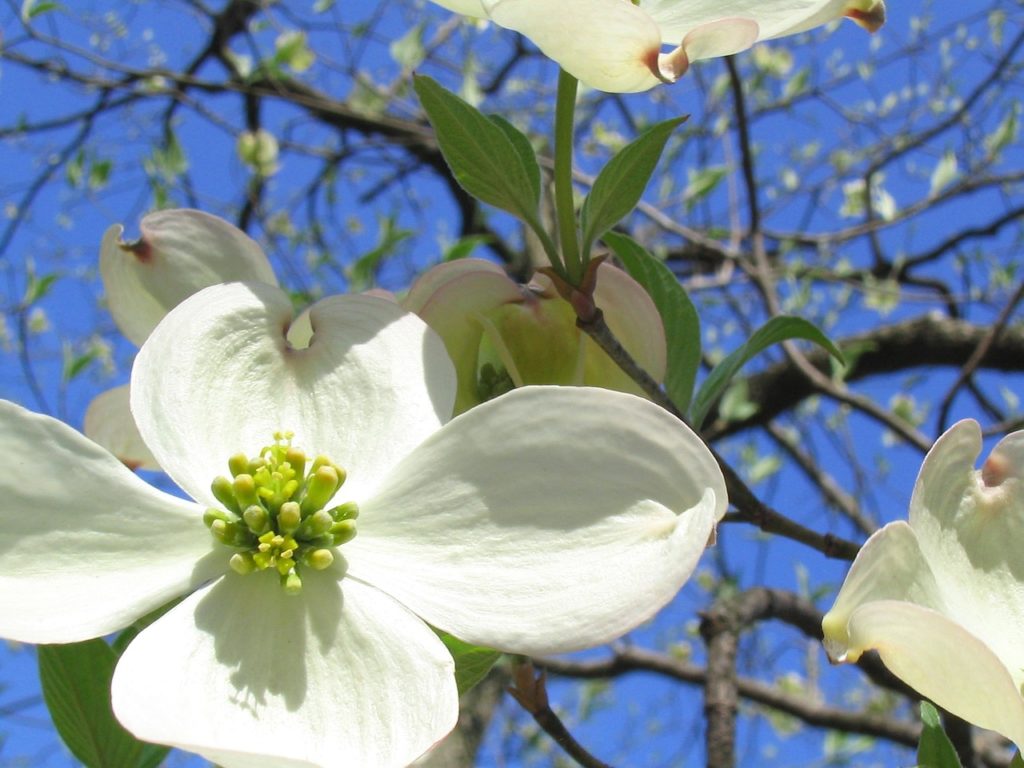This is the first half of a two part series on flowering dogwood. The following examines the tree’s distribution and habitat, developmental traits, longevity, height, bark, leaves, flowers, fruit, seed production, root development, and ideal soil conditions.
Introduction
Flowering dogwood (cornus florida), also referred to as dogwood or cornel, is one of the most popular ornamental trees in North America. It is considered an understory tree, developing beneath many other tree species, including oaks, hickories, yellow poplar, sweetgum, Virginia pine, loblolly pine, American beech, and red maple. Flowering dogwood often grows in conjunction with blueberry, sassafras, serviceberry, and brambles.
Distribution and Habitat
In the United States, the range of flowering dogwood extends from southwestern Maine to New York, west to central Michigan, central Illinois, and central Missouri, and south to southeast Kansas, eastern Oklahoma, eastern Texas, and northern Florida. Flowering dogwood also occurs frequently across Kentucky. In its southern range, flowering dogwood is one of the most abundant species in the understory of loblolly pines. In Canada, flowering dogwood ranges from southern Toronto to southern Ontario. In Central America, a variety of flowering dogwood grows in the mountains of Nuevo León and Veracruz, Mexico.
Developmental Traits
Flowering dogwood is a small deciduous tree. It has dense wood that is highly susceptible to decay. Saplings tend to have an upright to rounded growth habit. The crown of flowering dogwood is broadly pyramidal, with a round to flat-topped habit. Branches on the lower half of the crown have a horizontal structure, while those in the upper half grow upright. Flowering dogwood initially develops at a slow rate, but gradually assumes a medium rate as the tree matures. The trunk diameter of flowering dogwood seldom exceeds more than eight inches, though on ideal growing sites, it may reach up to sixteen inches.
Longevity
The average lifespan of a healthy flowering dogwood is eighty years.
Height
Flowering dogwood can reach between 15 and 30 feet in height, with a spread of 25 to 30 feet. Heights of 9 to 12 feet are common. Outliers may reach heights of up to 55 feet. On poor growing sites, heights of mature trees may range from 3 to 8 feet.
Bark
On saplings, the bark of flowering dogwood is purple to reddish-green, darkening to gray by the second year of growth. Bark is rough, with many square-like plates.
Leaves
The leaves of flowering dogwood are oval to ovate, and have an opposite arrangement. They grow 4 to 8 inches in length and width. Their edges are smooth. Leaves are dark green, with a pale green underside. They turn a vibrant scarlet to purple shade in fall.
Flowers
Flowering dogwood features many small, yellow-green flowers that are borne in terminal clusters. Flowers are surrounded by four snow-white, petal-like bracts that extend 3 to 5 inches in length. Once they have fully bloomed, flowers are conspicuous and showy, providing a spectacular display.
Occasionally, trees with light-pink bracts may be found in nature. Cultivars with pink or red flowers are commonly propagated, and used in landscape settings. Flowers emerge in spring, preceding budburst. Flowering ranges from mid-March in the south to late May in the north.
Fruit
Fruits are bright red drupes that form in clusters. Clusters are comprised of 2 to 10 drupes. Drupes are ½ inch in length, and diameter. Fruits have thin, mealy flesh. They carry a bitter taste, and are considered inedible to humans. Each fruit contains a two-seeded stone. In many stones, only one seed becomes fully developed. Fruits ripen from September to late October. They may linger on the tree throughout winter. At maturity, fruits become bright red or yellow, with a pink blush.
Seed Production
Germination of flowering dogwood typically occurs in spring. Some seeds will overwinter the first year, and germinate the following spring. Germination is epigeal, with one or more seed leaves appearing above the ground. Birds, and other woodland creatures are primarily responsible for disseminating seeds.
Root Development
Flowering dogwood establishes a shallow root system, which is moderately resistant to drought. Extended periods of drought can result in root damage stemming from moisture loss. Roots may erode, and die back. Flowering dogwood has low salinity tolerance, and may incur root damage when subjected to large quantities of salt.
Soil and Topography
Flowering dogwood can grow in a variety of soils: from deep, moist soils along streams to well drained soils in landscapes. The species prefers moist, acidic soil, with a pH level of 6 to 7. It often thrives in shaded areas, on flats, and on lower or middle slopes. It can also be found on upper slopes and ridges, albeit with less frequency. In forest stands, flowering dogwood is most prevalent on soils that are well-drained, and lighter in texture. The tree’s shallow root system precludes it from growing on dry sites. It is seldom found on poorly drained clay soils, where seedling survival tends to be low.
Flowering dogwood can withstand high temperatures, but may be stunted in planting locations that are exposed to constant heat sources such as parking lots, roadways, driveways, and sidewalks. In the southern regions, dogwood leaves often become desiccated, and wilt during bouts of dry weather. Extended periods of drought may cause the leaves to fall early, with branch dieback often occurring thereafter.


